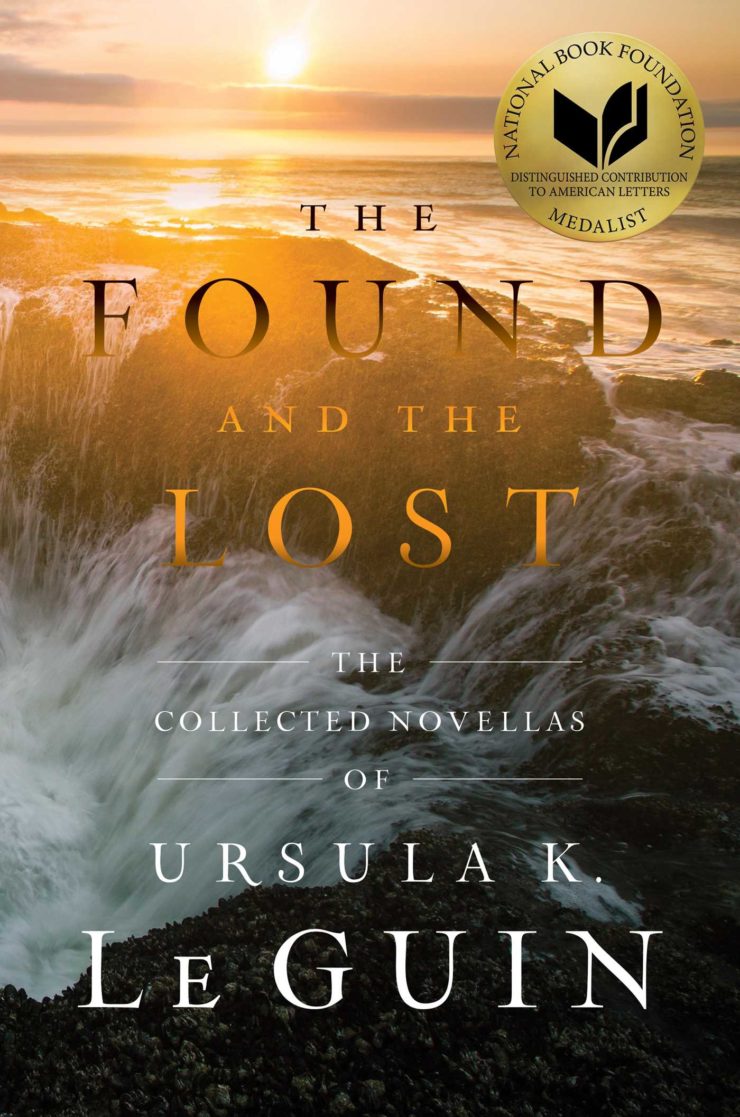It’s a good time to be an Ursula K. Le Guin fan, and an excellent time to become a convert. Among the numerous releases and rereleases slated for the next year, Saga Press has collected Le Guin’s short fiction into two stunning hardcover editions, released in October. The first, The Found and the Lost (novellas), I’ll attempt to tackle here. The second, The Unreal and the Real (short stories), I’ll explore later this year. In November the two collections will be released yet again, this time as a boxset (just in time, presumably, for the Holidays). But whether you buy these collections separately or together, you’re in for a treat. A graceful, intrepid, and sometimes devastating treat.
The Found and the Lost captures Le Guin at her most formidable, welcoming readers home to places they’ve never visited, and making the familiar stranger and stranger still. If you caught her Orsinia collection earlier this fall, these stories will feel right at home nestled within her pseudo-historical Europe. Revolution, community, and comings-of-age map as well onto alien planets as they do onto 19th century bildungsroman. And of course, glimpses into both the Earthsea Archipelago and the travels of the Ekumen will round out the collection for any long-time fans.
The novellas in The Found and the Lost are arranged roughly by publication date, and map not only Le Guin’s concurrent projects, but also the maturity of her themes. The earlier pieces are just as captivating, of course (“Hernes,” the collection’s only realist piece, stands out as a quiet intergenerational drama, reminiscent of Alice Munro). However, the differences between “Vaster than Empires and More Slow” (1971) and “Paradises Lost” (2002) are as stark as they are fascinating. Both stories feature teams of interplanetary explorers, and both deal heavily with the horrors of isolation and of confronting the other. “Paradises Lost,” though, explores this dread with a compassion and patience that the first denies in favor of plot movement. It is, in more ways than one, the culmination of the collection, drawing together the community-building and existential malaise of all the previous stories into a captivating and ambivalent conclusion.
Though the Found and the Lost isn’t exclusively a Hainish collection, the cycle does occupy a significant portion of it. Some stories, like the two mentioned above, are linked to the literary universe more tenuously. However, four stories stand out in particular, creating a mini-collection of their own in the middle of the book: “Forgiveness Day,” “A Man of the People,” “A Woman’s Liberation,” and “Old Music and the Slave Women” are all set on the planet Werel and its slave colony Yeowe. The traditional culture on these planets enforces a strict division between man and woman, and between freeman and slave. After a slave rebellion on Yeowe, and after the Ekumen begin to passively meddle in the worlds’ politics, these divisions begin to break down. Each of the stories focus on a different experience of the crumbling society, whether from the perspective of an Ekumen diplomat that befriends a women’s rebellion, or a traumatized soldier from Yeowe’s civil war. The Werel stories are the collection’s clearest instance of Le Guin’s ongoing literary project of intersectional justice. A world enslaved may treat its women as poorly as a revolution does, and the personal is sometimes kinder, sometimes crueler than the political. The richness of the culture Le Guin depicts is painfully real, at once beautiful and deplorable. Her ability to make not only her outsider-protagonists at home in this degraded world, but her “enlightened” readers, is a feat that should not be overlooked.
It is this sense of home that makes the collection, as well as Le Guin’s whole oeuvre, worth returning to. To Le Guin, the found and the lost aren’t merely metaphysical states, but embodiments; they’re the spaces we find ourselves in when we are lonely, between worlds, creating a community. The Found and the Lost maps Le Guin’s mastery of place—of home, of dysphoria, of wilderness—in a way that no singular work or series does on its own. It is the similarities between Earthsea, Hain, and Werel that capture Le Guin’s genius, rather than each world’s detail and ingenuity. No matter where these stories take you, you will be lost and you will be found, enraptured with possibility and grieving for the paths you didn’t take.
The full table of contents, along with the dates of publication and accompanying series are listed below:
Table of Contents
- Vaster than Empires and More Slow (1971, Hainish Cycle)
- Buffalo Gals, Won’t You Come Out Tonight (1987)
- Hernes (1991)
- The Matter of Seggri (1994, Hainish Cycle)
- Another Story or a Fisherman of the Inland Sea (1994, Hainish Cycle)
- Forgiveness Day (1994, Hainish Cycle)
- A Man of the People (1994, Hainish Cycle)
- A Woman’s Liberation (1994, Hainish Cycle)
- Old Music and the Slave Women (1999, Hainish Cycle)
- The Finder (2001, Earthsea)
- On the High Marsh (2001, Earthsea)
- Dragonfly (1997, Earthsea)
- Paradises Lost (2002, Hainish Cycle)
The Found and the Lost is available now from Saga Press
Emily Nordling is a library assistant and perpetual student in Chicago, IL.










